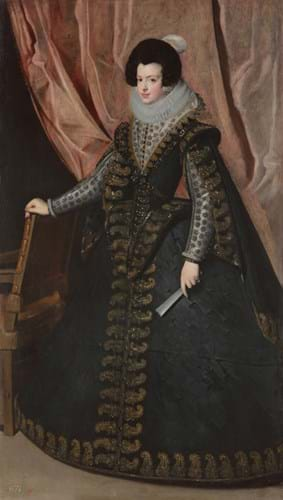
A portrait of Isabel de Borbón, Queen of Spain, by Diego Velázquez, estimated ‘in the region of $35m’ at Sotheby’s New York.
Depicting the first wife of Velázquez’s leading patron, Philip IV of Spain, it shows the sitter in her mid-20s wearing a black court dress. It will carry an estimate ‘in the region of $35m’.
With most Velázquez royal portraits now in museum collections, a consignment such is this is highly rare. Sotheby’s said that the last time a portrait of this caliber by Velázquez came to auction was in 1970 when his famous painting of Juan de Pareja sold for £2.3m at Christie’s in London – becoming the first million-pound picture and nearly tripling the previous record for anything sold at auction at the time.
Only a handful of autograph paintings by Velázquez have emerged at auction since then. The current record for the artist stands at £7.5m for a half-length portrait of Saint Rufina that sold at Sotheby’s London in 2007.
When asked about the source of the current work and whether the consignment will be guaranteed, a spokesperson for Sotheby’s said it has come from a US family trust and “at the moment it just has a house guarantee”. This suggests that the auction house has given the vendor a guaranteed price but may well seek to offset the risk by arranging an ‘irrevocable bid’ from a third party ahead of the auction (often made in return for a financial incentive if they end up being outbid).
ATG also made enquiries about the condition of the 6ft 7in x 3ft 8in (2.07 x 1.19m) oil on canvas. Sotheby’s international head of Old Masters Christopher Apostle said: “The painting is in very good condition overall, with very minimal retouching. Particularly impressive for a painting of this scale and age.”
Before the sale in New York on February 1, the portrait will be displayed at Sotheby’s New Bond Street galleries from December 1-6, its first appearance in the UK in a quarter of a century. Sotheby’s chairman and co-worldwide head of Old Master Paintings George Wachter said: “This grand portrayal of Isabel de Borbón is an exceptional example of the artist at the height of his powers, shaping the direction of portraiture for generations to follow. No other Velázquez paintings of this scale and importance have come to the market in more than half a century.”
Provenance
The portrait of Isabel remained in the Spanish royal collection for much of its history, hanging for many years at the Buen Retiro palace in Madrid as a pendant to the artist’s portrait of the Philip IV (also shown wearing black) that is now in the Museo del Prado. It next had a spell in the Louvre following Napoleon’s invasion of Spain in 1808 where it was kept until 1838.
It was later sold to the merchant banker and noted book collector Henry Huth, who displayed it at Wykehurst Park in Sussex, and in whose family it remained until it was sold in 1950 – the last time it appeared on the auction market.
It has been in the collection of its current owners in the US since 1978.
Artist’s revisions
Velázquez painted the portrait in the late 1620s but, as with the portrait of her husband Philip IV which was painted at the same time, the artist returned to the canvas in 1631-32, re-working various aspects of the costume and composition. He made series of changes, some of which – such as the lowering of the Queen’s arm and the shift of the outline of the skirt – can be seen with the naked eye.
It is thought these revisions were prompted by two things: first, a desire to update the costume, image and style of an earlier underlying painting by the artist; and second, a simultaneous desire, on Velázquez’s part, to demonstrate a new approach to painting, heavily influenced by his recent, first-hand encounter with Sir Peter Paul Rubens.
The sitter
Isabel de Borbón was the daughter of Henri IV of France and his second wife, Marie de Médicis. Prior to her marriage, she was known as Elisabeth of France.
Her marriage in 1615 at the age of 13 to Philip IV of Spain, who himself was only 10, helped the diplomatic relations between those two countries. Isabel and Philip would have six daughters, only one of whom lived to adulthood (the Infanta Maria Teresa of Spain, memorably depicted by Velázquez in a portrait now at the Metropolitan Museum of Art). They also had a son, Baltasar Carlos, who was painted by Velázquez numerous times but who died before he could become king.
Isabel herself died in 1644, after which Philip IV went on to marry Mariana of Austria.





